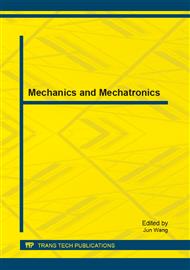[1]
Yoonsu Nam, Sung Kyung Hong. Force control system design for aerodynamic load simulator. Control Engineering Practice 10 (2002) 549–558.
DOI: 10.1016/s0967-0661(02)00004-7
Google Scholar
[2]
Jiao Z X, Gao J X, Hua Q, et al. The velocity synchronizing control on the electro-hydraulic load simulator [J]. Chinese journal of aeronautics, 2004, 17(1): 39-46.
DOI: 10.1016/s1000-9361(11)60201-x
Google Scholar
[3]
Jiao Z, Hua Q, Wang X, et al. Hybrid control on the electro-hydraulic load simulator[J]. Jixie Gongcheng Xuebao(Chinese Journal of Mechanical Engineering)(China), 2002, 38(12): 34-38.
DOI: 10.3901/jme.2002.12.034
Google Scholar
[4]
Wang X, Wu J, Wu L. The Force Control Method Based on 6-DOF Parallel Electro-hydraulic Servo Mechanism[J]. JOURNAL-SHANGHAI JIAOTONG UNIVERSITY-CHINESE EDITION-, 2007, 41(1): 0111.
Google Scholar
[5]
Wu Lebin, WANG Xuanyin . Study on the Joint-Space Coupling Characteristics of a Generalized Load Simulator[J]. Journal of Astronautics(China), 2010, 31(5): 1464-1467.
Google Scholar
[6]
Liang Laiyu . Research and Implementation of Super Large6-DOF Load Platform System[D], Huazhong University of Science and Technology, (2011).
Google Scholar
[7]
Li Chang . RESEARCH OF FORCE LOAD CONTROL BASED ON 6-DOF MOTION PLATFORM[D]. Harbin Institute of Technology, (2011).
Google Scholar
[8]
Liu X J, Wang J, Pritschow G. Kinematics, singularity and workspace of planar 5R symmetrical parallel mechanisms[J]. Mechanism and Machine Theory, 2006, 41(2): 145-169.
DOI: 10.1016/j.mechmachtheory.2005.05.004
Google Scholar
[9]
Whitney D E. Historical perspective and state of the art in robot force control[J]. The International Journal of Robotics Research, 1987, 6(1): 3-14.
Google Scholar


